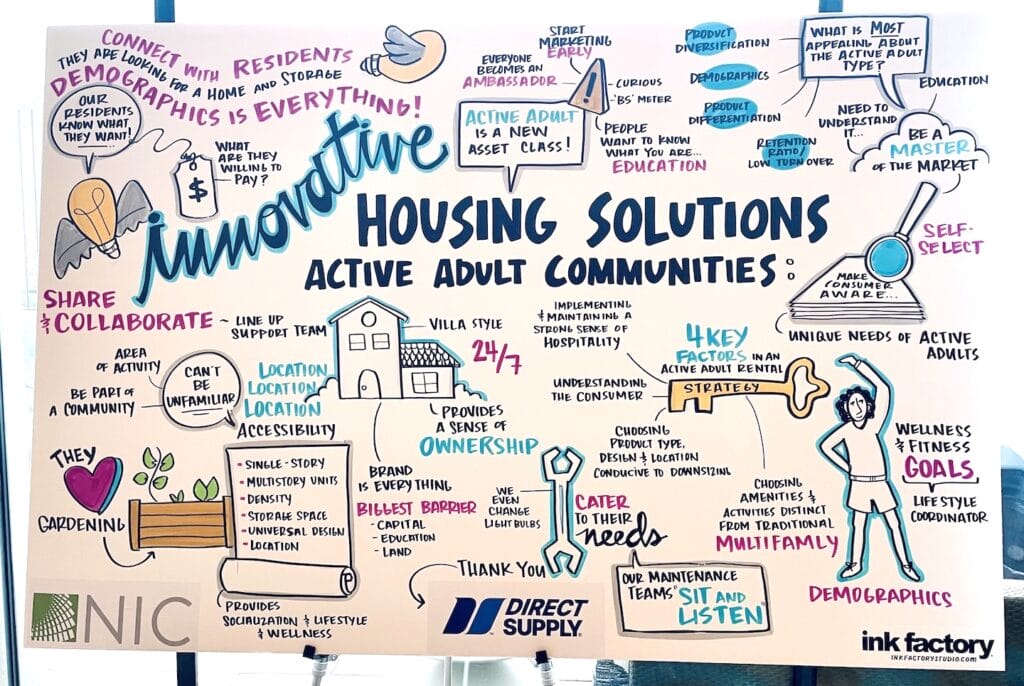
DALLAS — The senior living industry’s active adult niche will do best if well-executed, and that starts with understanding the consumer, according to experts speaking at the National Investment Center for Seniors Housing & Care Spring Conference.
“It’s a far more complicated demographic than we were led to believe,” said California-based Avenida Partners Managing Director Robert May. “They are part of the baby boom generation that has moved our economy, and their expectations are high.”
NIC defined the growing “active adult” property type in 2022 as “age-eligible, market rate, multifamily properties that are lifestyle focuses; general operations do not provide meals.”
Never underestimate the consumer, was May’s warning. Whether it’s through their influence group, friends or adult children, prospective active adult residents already know about a provider before they visit a community.
“It’s all about the community — what you have there, and why it’s worthwhile,” May said. “The greatest fear a senior has isn’t about death. It’s about running out of money.”
Although active adult is not a needs-based product, May said that operators must make prospective residents feel as if they need it. It goes back to the value proposition of the sector, he said: showing people why they would be happier and why an active adult community is a better place to be than where they are now — namely, socialization, wellness and lifestyle.
“Our customer is very discerning, and they’re coming from home,” said Ohio-based Treplus Communities CEO and co-founder Jane Arthur Roslovic. “And they’re aging. They think really hard about where they’re spending their money.”
Selling active adult’s story
The biggest challenge is increasing awareness of the property type, May said.
Roslovic joked that maybe it’s time for a “Got Milk” campaign to explain the active adult segment as a new asset class. It’s an educational process for everyone — the communities/municipalities in which communities are located, other stakeholders, and even existing single-family businesses in the area, she added.
When it comes to selling a project to lenders and investors, May said, the industry has produced enough data points in every major metropolitan area that can be used as a reference point — what the market has demonstrated as its willingness to pay for the product. The demographics, he said, are there.
From a tenant profile, May said active adult residents are going to stay for five to 10 years. And “they’re great tenants” — they don’t beat up the property, they pay on time and they are not so sensitive to rent increases — as long as providers deliver on the value proposition.
“It’s an awesome segment to be in,” May said.
Lifestyle coordinators are ‘critical’ employees
Selling that value proposition starts with a lifestyle coordinator, May said, The position is a critical part of the team, he added, because the person in the role see residents daily.
“They are your eyes and ears for your residents — who is participating, who is maybe beginning to diminish. They’re also able to connect with residents as to what they really want,” May said. “That lifestyle coordinator has to be able to speak to all of those things and to be the friend of the resident to help them reach their goals.”
The person in the position gathers all of that input from residents and creates a feedback loop back to the community manager and leasing office, creating a dynamic, organic process, he said.
Third phase of life
Capital is the biggest barrier to entering the active adult space, he said. But when the money unfreezes, May added, everyone will be able to take advantage of the “extraordinary amount of pent-up demand” that is out there for the property type, which provides a connected and engaged lifestyle for residents in the “third phase of life.”
Roslovic said that the transition from homeowner to renter creates an interesting perspective to manage from, adding that some days, an active adult community is more like a condo association because residents “really want to weigh in” on decisions that affect the community.
“Our residents are downsizing from a home, and their home is very important to them, and they want to be proud of their home,” Roslovic said. “They’re still letting go of being a homeowner.”
She said that the sense of community is important because older adults are trying to navigate that third phase of life, and it’s different.
“Our experience is, they’re looking for what we build and what we’re going to deliver,” May said. “And then they want their friends to come along.”



